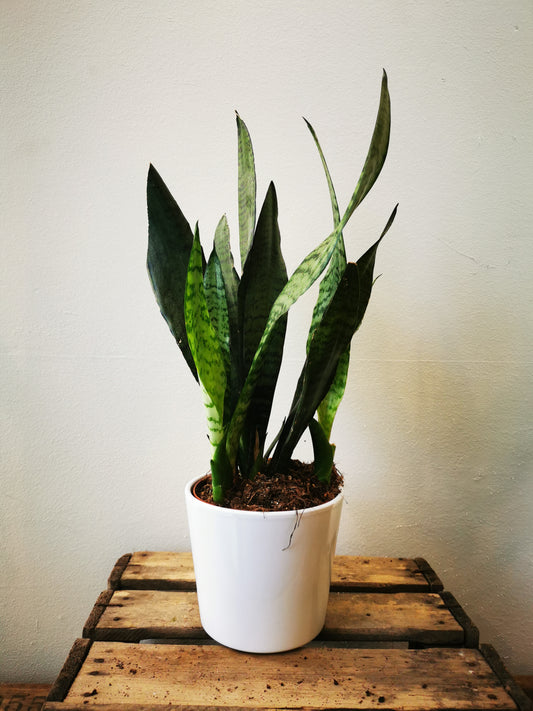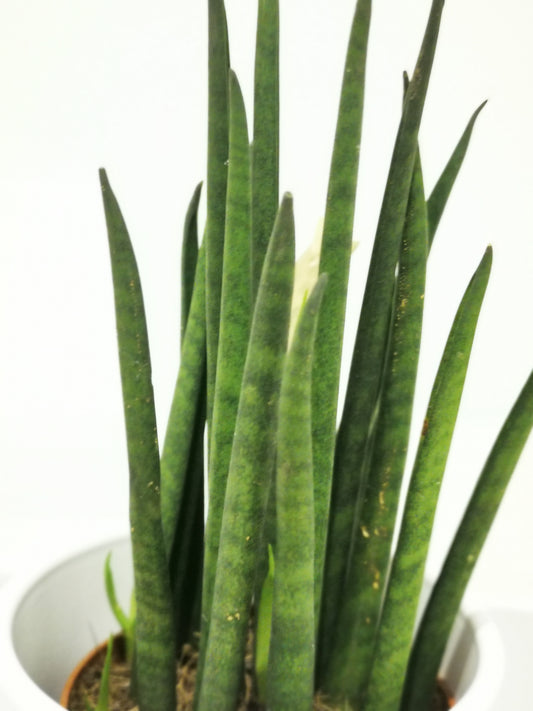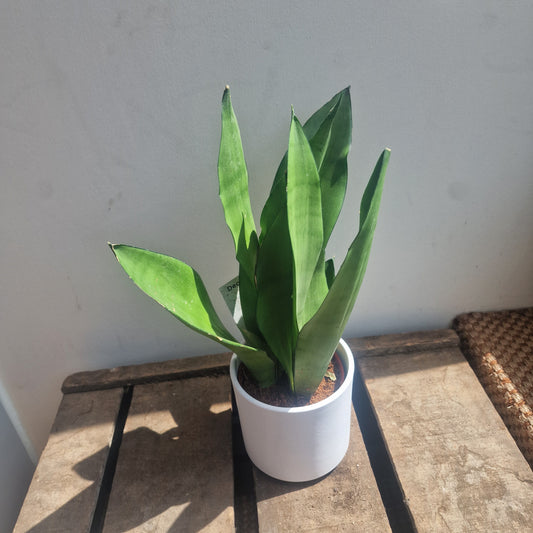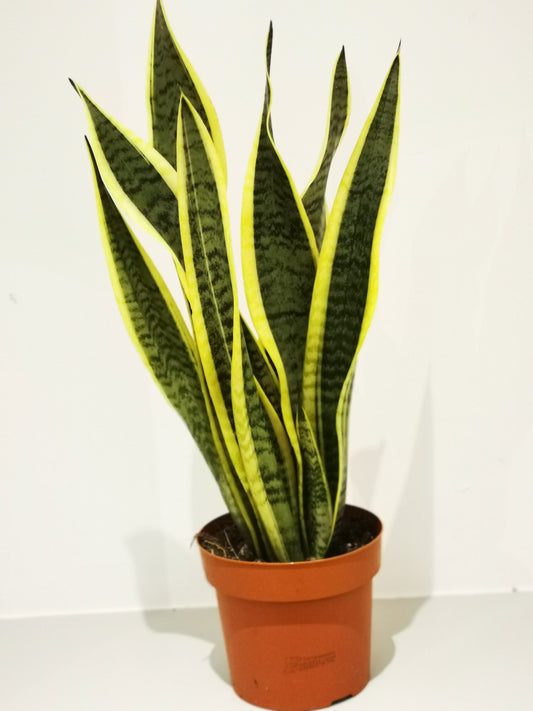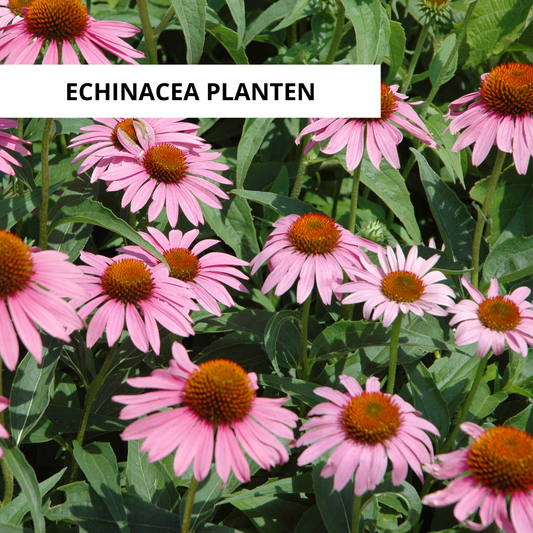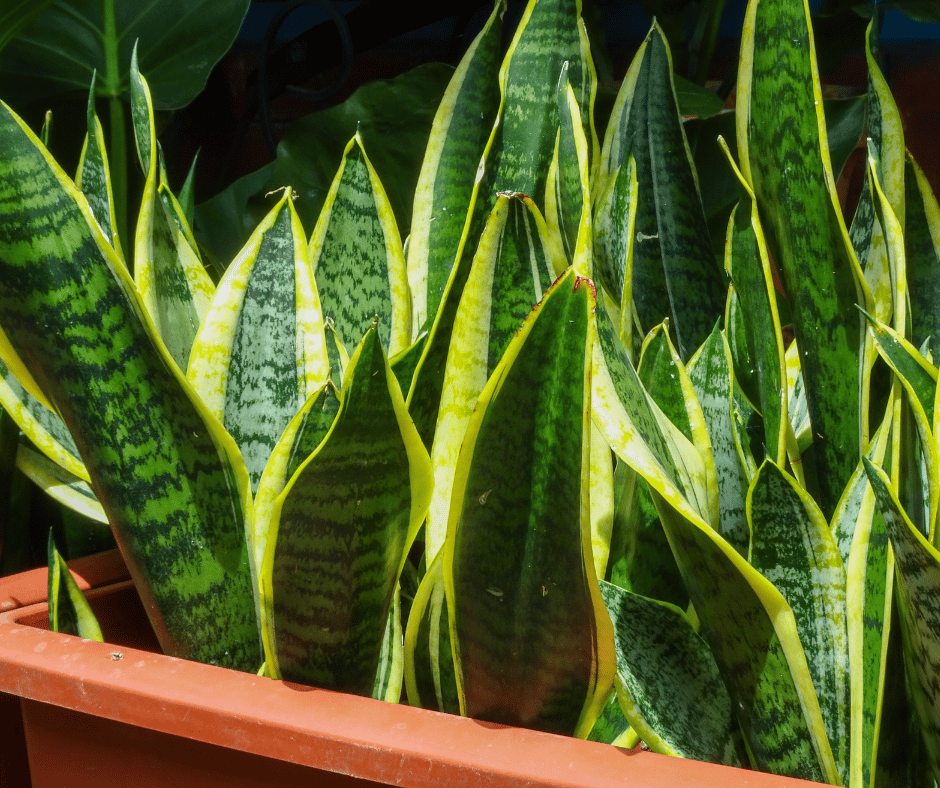
How to care for a Sansevieria
Share
The Sansevieria, also known as the Mother-in-law's Tongue, is a popular houseplant that is loved for its striking appearance and easy care. In this blog post, we will tell you everything you need to know about this resilient plant. From different types of Sansevieria to care tips, cutting methods, toxicity and what to look for when buying a Sansevieria. Discover how you can create a green paradise in your interior with this versatile plant.
The Sansevieria
The Sansevieria is a succulent plant that originates from dry areas in West Africa. It is known for its elongated, pointed leaves that grow upright and vary in color and pattern depending on the species. The plant can be grown both indoors and outdoors and thrives in a variety of environments.
Types of Sansevieria
There are several types of Sansevieria available, each with its own unique characteristics. Some popular types include:
- the Sansevieria trifasciata,
- the Sansevieria cylindrica,
- the Sansevieria moonshine,
- the Sansevieria Fernwood,
- the Sansevieria Whalefin,
- the Sansevieria Laurenti,
- the Sansevieria Mikado,
- the Sansevieria Futura Superba ,
- the Sansevieria Zeylanica.
Each of these species has its own growth patterns, leaf colors, and care requirements.
Where does the Sansevieria grow?
In the wild, Sansevieria grows in dry and rocky areas of West Africa. These plants thrive in warm temperatures and tolerate drought. They can also be grown indoors, as they adapt well to different light and temperature conditions.
Caring for the Sansevieria
To keep your Sansevieria healthy and beautiful, it is important to provide the right care. Here are some essential aspects of Sansevieria care that you should know.
How much water does the Sansevieria need?
The Sansevieria is a succulent plant that is very drought resistant. It is important to water the plant sparingly and to ensure good drainage to prevent root rot . Allow the soil to dry thoroughly between waterings.
How much light does the Sansevieria need?
The Sansevieria thrives in both light and shaded environments. It can adapt to different light conditions, but avoid direct sunlight, especially with more sensitive varieties. Place the plant in a room with bright, indirect light.
What kind of potting soil does the Sansevieria need?
Sansevieria thrives in a well-draining potting mix. Use a mixture of cactus potting soil mixed with a little sand or perlite to promote good drainage.
Cutting the Sansevieria
Propagation of Sansevieria can be done by means of leaf cuttings or by dividing/dividing the plant.
Leaf of the Sansevieria cuttings
Cutting a Sansevieria can be easily done by cutting a healthy leaf from the mother plant and placing it in a pot with moist potting soil. Make sure the leaf is upright and will develop roots.
Dividing or splitting the Sansevieria
Another way to propagate Sansevieria is to divide or split the plant. This can be done by carefully dividing the root ball into several parts, making sure that each part has sufficient roots.
Is the Sansevieria poisonous?
Yes, Sansevieria is toxic to pets and can cause mild to moderate symptoms if ingested. It is important to keep the plant out of reach of children and pets.
Want to know more about the toxicity of Sansevieria for cats, dogs and children?
Is the Sansevieria the mother-in-law's tongue?
Yes, the Sansevieria is also known as the mother-in-law's tongue because of the shape and structure of the leaves.
Do Sansevierias produce flowers?
Sansevierias can produce flowers, but it is not common and depends on several factors. In general, Sansevieria flowers are considered small and inconspicuous. The flowering period can occur under certain conditions, such as sufficient light, warmth, and specific care. It is important to note that not all Sansevieria varieties flower and flowering is usually not the primary reason why people choose this plant.
When a Sansevieria flowers, it often produces tall, upright stems with small flowers at the top. These flowers can be a variety of colors, ranging from white to greenish yellow. While the flowers are not the most striking feature of the Sansevieria, they do add an extra element of interest to the plant.
Encouraging flowering in Sansevierias can be tricky, but the following tips can help. Make sure the plant gets enough light, preferably bright indirect sunlight. Placing the plant in a warm environment with a constant temperature can also increase the chance of flowering. Keep in mind, however, that even under ideal conditions, not every Sansevieria will flower every year.
Remember that the beauty and attractiveness of Sansevierias does not only depend on their flowers, but mainly on their striking leaf shapes and patterns. So even if your Sansevieria does not flower, it will still be a beautiful addition to your interior with its sturdy, upright leaves that add a touch of green and style.
What to look for when buying a Sansevieria?
When buying a Sansevieria it is important to look for healthy leaves without signs of disease or damage. Also check for a firm root ball and avoid plants with rotten roots.
The Sansevieria is a versatile and resilient houseplant that is perfect for your interior. With several varieties to choose from, the Sansevieria offers a striking appearance and easy care. By providing the correct watering, sufficient light and suitable potting soil, you can ensure that your Sansevieria thrives. Propagation of the plant can be done through leaf cuttings or division/splitting. Be careful though, as the plant is poisonous to pets. When buying a Sansevieria, look for healthy leaves and strong roots. Bring greenery and style into your interior with the beautiful Sansevieria!

